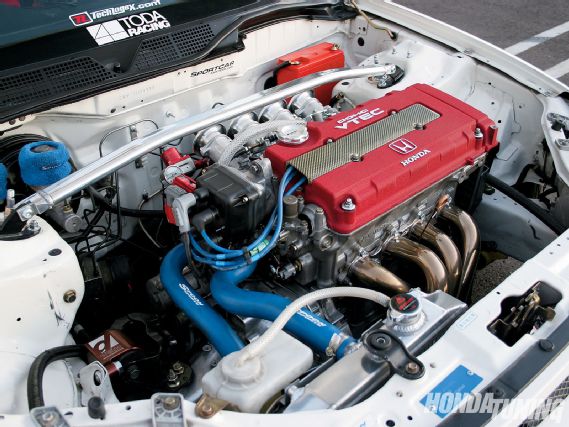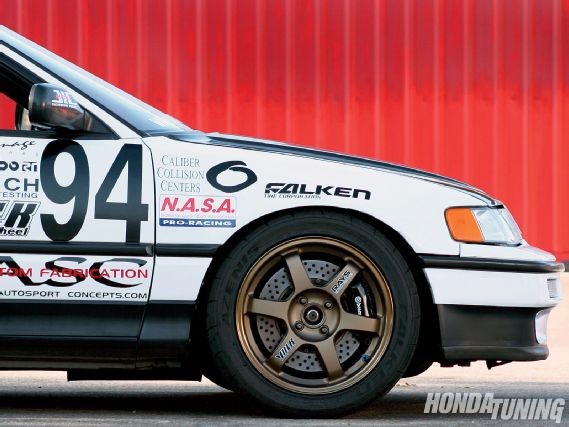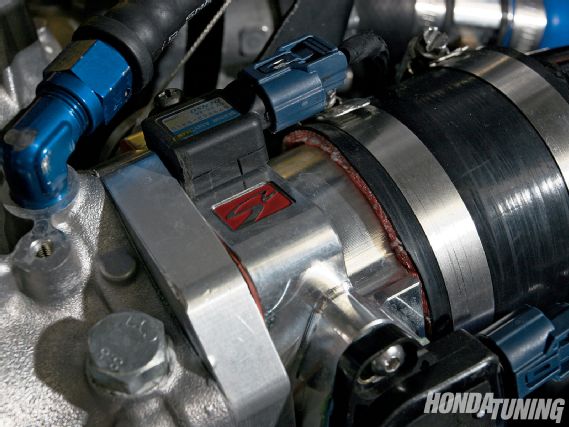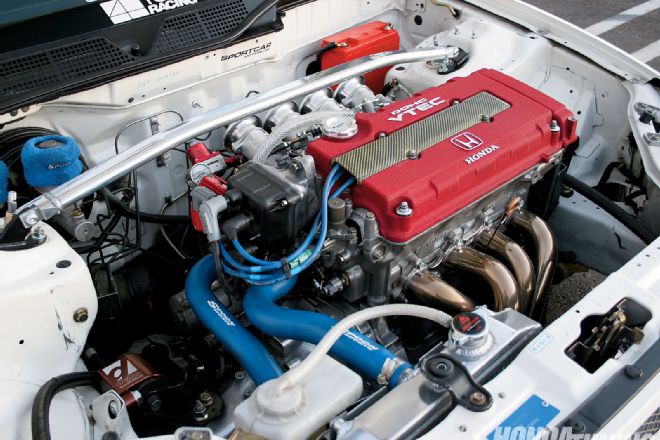Questions Answered By Honda Expert, Ryan Basseri Of Rywire.
•www.rywire.com
Great Magazine! I've been a reader for years now. I've been building a fifth-gen Accord now for quite a few years. It's got an H22 with lots of bolt-ons and suspension mods. Lately the H is burning oil and I remembered you did a technical article on the H blocks not long ago. In that article you mentioned that it's possible to have the FRM lining reapplied to the cylinder walls if they're bored slightly over so you don't have to always sleeve the block, which is what you opted for in the article. I just recently acquired another H22 for a turbo build and had the block sleeved. I now find myself with two Hs needing attention and the more I can save on one, the more gets spent on the other. What is a ball park figure for having a machine shop reapply the FRM lining on the block and what shops can help me out with this? I know price varies from shop to shop but after sleeving one I would like to try this other route as well. Oh, I just recently picked up another clean fifth-gen so both engines will have homes-sooner rather than later with your help. Keep up the great work and thanks for any help you can provide!
Josh
 |
2006 Acura TSX - Exhaust Notes
|
2006 Acura TSX - Exhaust Notes
Josh, the fiber-reinforced metal liner rejuvenation process should only be a couple hundred more than a standard bore and hone, but an experienced installer with experience needs to do it to ensure a correct finish is applied. Depending on if you ever decide to run boost or forged internals on this motor, you might just opt to get this one sleeved as well.
Love your magazine, and obviously Honda. I have been into them for seven years. I am partially ASE certified and love every aspect of even the simplest cars, but there is one thing I cannot get my head around. It's the stabilizer bar. Many may write this item off as a simple piece of the suspension pie, but that, I refuse to swallow. It affects so many factors as to which is it's actual intended purpose is. What else does this simple torsion bar do for us, and when is it best left out? Many are quick to grab the stiffer/thicker bar but this can't always be best. Help!
Kevin
Anti roll bars keep the car's body from "rolling" in a sharp turn. In a right turn for example, the left wheels are stuffed into the ground and the body of the car on the low side is forced up (right side wheels). You could end up going so fast into a corner that your wheels on the low side can lift off the ground. Maintaining a constant contact patch between your tires and the concrete will allow you to drive faster through a turn.
The anti roll bar helps to distribute the weight evenly and keeps the car flatter into the turn. The flatter the car stays, the better. If you over-size the bar it can actually work against you, losing independence of the suspension. This will cause the wheels to feel joined and any road inconsistency on one wheel will end up being shifted to the other side of the car, making the car feel off balance. The key here is to size a bar that is a happy medium between too stiff and not stiff enough. In most cases slightly bigger in the rear on our FWD Hondas will help rotation in a turn. As you may have noticed it's not easy to get a FWD car to rotate correctly-they tend to want to under-steer like crazy.
Hey guys, I'm sure you get similar emails all the time but I could use your help. I drive an H22-swapped EG hatch and have enjoyed it for several years without incident. The plan has always been to boost it eventually, but when I do, it would be done right (sleeved block, forged pistons/rods, Hondata). My problem started when a friend purchased a '99 GSX with a 16g, DSM link, all the supporting engine mods, and Tein SS coilovers. I expected the car to be pretty quick in a straight line with the claimed 328 whp and AWD, but it didn't handle as bad as I thought it would considering the added weight compared to my hatch. Now said friend plans on upgrading just about all of his engine parts to bigger and better examples and I can get them in excellent condition on the cheap. This got me thinking about selling the H22, swapping in the D16y8 that i have lying around to keep the EG as a daily, and selling my current daily DA Integra to buy a 2G DSM to build as my go fast car. I must say that I absolutely love the H badge and will always at least have one as my daily driver, but the lure of AWD and an engine that was actually designed to have a turbo strapped to it is great. What would you guys do in my shoes? Continue on the expensive H22 turbo path or go DSM? Sorry for rambling. Any input would be awesome. Thanks
Rick Santora
Pittsburgh, PA
 |
2006 Acura TSX - Exhaust Notes
|
2006 Acura TSX - Exhaust Notes
Hey Rick, this dilemma is truly personal preference; it's totally up to you!! I can say that I have a love for Hondas and I would never buy a DSM. I've worked on them, and my friends have owned them in the past... In my opinion you might be best off keeping what you have. Sometimes using free parts and an unknown chassis can create more problems than you think. My buddy Ted has a 4g63 Talon drag car with a built motor and let me tell you, that thing is insane! It's a different world compared to Hondas , but the principals are still the same; do not cut corners, buy quality parts, and remember, you get what you pay for. I am sure you can make either car fast with some hard work and the cash to fund the project. One big plus is the fact that the police won't be on your butt as much, and you won't be as much of a target for thieves. One downside is you'll be driving a DSM, yuck (just kidding). Good luck with your decision!
Hey guys, love the magazine! I have a couple of questions for you. First, what's the best cam set up for a b18? A stock b16, or a b20? I've just ported and polished the head and I'm looking for easy power. I'm also about to bore my throttle body but I need to know how big I can go, and where to get a new throttle plate. Also, will B18c head bolts work for my B18b head? Any help you can give me is really appreciated. Thanks so much. Keep up the great work!
Shawn Jones
Knoxville, TN
First off, you need to be specific on what head you are using. I assume you have a B18b head and that is what you just ported. As for your cam choices, VTEC cams will not work on non-VTEC heads. There is an extra lobe for the higher lift profile. However, you are in luck, because there are aftermarket cam shafts available for the non-VTEC heads. If the B18 you're referring to is a GSR or ITR, there really is not a "best" set of cams for your motor. You need to determine what your goals are, what type of driving you'll be doing, and your supporting modifications before buying a random set of bumpsticks.
If you are looking for easy power, a small turbo on low boost would be a great upgrade, or even simply a VTEC head swap.
As far as the throttle body goes, there are many aftermarket options, like Skunk2 or BDL. If you have your heart set on OEM, you should be able to go to about 65mm on a stock B16a throttle body. Whoever bores it out should be able to make you a new plate in the larger size to match the porting. To answer your last question, no do not try and use the B18c head bolts; they will not all work correctly.
What's up HT? I've been hooked on your mag ever since I drove my best friend's fifth-gen Honda Accord back in the '90s. One day I came across a good deal on an '06 Acura TSX and found out that in Japan it's an Accord Euro R. I was so stoked! Now I want to start my own project build. Well my question is about Sound Performance's "Quick Spool Valve". Has anyone used it for street or road racing? I was thinking of a K20 setup with a BC stroker (92 x 87 bore) with 9.5:1 comp, and a GT3071 or 76R- divided T3 turbine housing with undivided exhaust manifold-and the list goes on. What characteristics could I see from this? Thanks for your help.
 |
2006 Acura TSX - Exhaust Notes
|
2006 Acura TSX - Exhaust Notes
P.S. In the middle of writing this my wife went into labor with my son Sean, a future wrencher and Honda Racer!
For the price of that Quick spool valve I would have to say no, I do not think it's worth it. I have heard little about it, and until the product has established itself in the market, I think it would be a good idea to hold off, at least for a budget build. A TSX on boost always brings a smile to my face. You should have plenty of fun with this setup, and I am sure you and your little boy will be more than impressed with the power!
What's up Honda Tuning? My name is Mercedes and first I want to say thank you for continuing to pump out such good f*%#ing material month after month! I could never get bored of your mag. I have a '91 CRX Si and I plan on swapping in a B-series VTEC motor and converting to OBD-1, hopefully sooner than later. The motor is sleeved and is filled with forged pistons and rods. The pistons are 13.5:1 compression. I have nearly everything to do the swap, including mounts, shift linkage, axels, OBD-1 ECU that reads on the side 37820-P61-A00, a Rywire OBD-0 to OBD-1 jumper harness, and an OBD-1 distributor. I'm also going to be upgrading my brakes to a Fastbrakes system and I plan on buying a Hondata kit. So I have three questions for you: 1) Do I need to buy a distributor jumper harness to run the OBD-1 distributor with this setup? 2) Can I start this thing up on pump gas right away, or will it need to be tuned first? I have read that it would detonate, but I don't know. 3) Can an ITR brake booster and master cylinder be put into my little EF chassis? I don't know if you need this info but here it is: Other engine mods include aftermarket throttle body, intake manifold, fuel rail, fuel pressure regulator, 440cc injectors, skunk2 pro2 cams and cam gears, Walbro fuel pump, titanium retainers and dual valve springs, intake, header, and soon, exhaust. Please let me know if I'm missing anything to complete the swap. Thanks for your time and knowledge.
Mercedes Aispuro
Mercedes, you'll need an OBD1/2 distributor for sure if you plan on using that OBD-1 ECU. You can do one of two things. First, you can buy a distributor jumper from us at Rywire.com, or you can re-pin it yourself. It's basically color to color when you are doing the SI or HF to OBD-1. One thing to remember, there is 1 wire that is off, so tear off the tape and find the white wire that is not in the shielding. Segregate this wire, and wire it up last. This wire needs to be matched to the yellow/green wire on the OBD1 side for the igniter. FYI, the pins from the OBD-0 will fit in the OBD-1 plug. Also, some jumper companies do not pin this way, but the Rywire version is as stated.
If you have a good base map you can start it up (idle) on 91 to make sure it fires/runs. I then suggest towing it to a reliable tuner to get it squared away.
Yes, an ITR master and brake booster can fit in a CRX. You need to adjust the push rod to match the pedal-to-firewall distance, and you will need to re-bend the brake line to fit in the new position. Note, some year ITR master cylinders have ABS and use a larger fitting. You will have to cut and re-flare a new 45 degree fitting. I suggest a 90+ DA master and booster. The fittings and lines are the same, and the size is just slightly smaller than the ITR unit.
Hi, I have a DOHC '91 Honda Ballade 160i. I want to know if I can get the engine of the previous flip-up light Honda ('89), also DOHC, but also want to know if I can use my distributor on the motor? Also, will the gearbox or head of the '89 model fit on the newer '91 model?
Raymond
Raymond, If I understand you correctly you are asking if the four-door '91 DOHC ZC engine is any different than the four-door '89 DOHC ZC engine. The answer here is that they are exactly the same. You should be able to mix and match parts freely between years. If you are referring to the '92-'95, then no, you could utilize the engine and that's all. You would keep the gear box and distributor from the original car.

